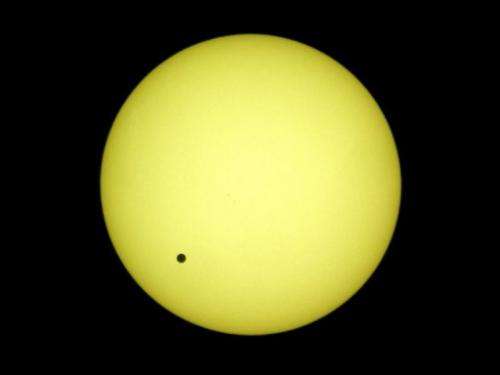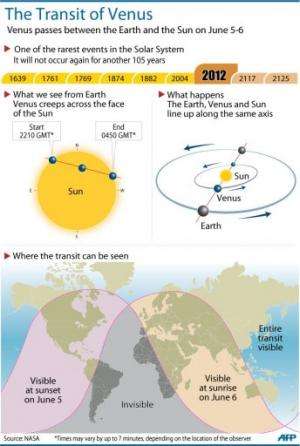The planet Venus transits in front of the Sun in 2004. Astronomers around the world will be using advanced telescopes to watch Venus cross in front of the Sun on June 5 and 6 in the hopes of finding clues in the hunt for other planets where life may exist.
Astronomers around the world will be using advanced telescopes to watch Venus cross in front of the Sun on June 5 and 6 in the hopes of finding clues in the hunt for other planets where life may exist.
By studying the atmosphere of a well-known planet in this once-in-a-lifetime event, scientists say they will learn more about how to decipher the atmospheres of planets outside our solar system as they cross in front of their own stars.
"There are many, many of these events that are observed for distant stars. The thing is that stars are just points of light because we are so far away, so you can't actually see what is going on," Alan MacRobert, astronomer and editor of Sky and Telescope magazine, told AFP.
However the transit of Venus, an event that will not happen again for another 105 years, or until 2117, offers a chance to practice decoding the atmosphere of a planet based on the impression it leaves on its star's light.
"The idea is some of that starlight skims through the atmosphere of the planet and the atmosphere leaves its imprint on that tiny, tiny little bit of a star's light," MacRobert said.
"If you can separate that from the rest of the star's light -- analyzing the light before, during and after the transit and looking for the difference -- you can actually tell something about the planet's atmosphere," he added.
"And this is absolutely at the cutting edge of present day technology."
The beginning of the transit will be visible in North America, Central America and the northern part of South America on the evening of June 5, as long as the skies stay clear. The end will not be seen in these regions due to sunset.
All of the transit will be visible in East Asia and the Western Pacific.
Astronomers around the world will be using advanced telescopes to watch Venus cross in front of the Sun on June 5 and 6 in the hopes of finding clues in the hunt for other planets where life may exist.
Europe, the Middle East and South Asia will get to see the end stages of the eclipse as they go into sunrise on June 6.
However, due to the risk of blindness or painful, permanent eye damage, people should not look directly at the Sun without a proper solar filter to try and observe the tiny black dot crossing its surface.
Global astronomers are keenly searching the universe for hints of a rocky planet like Earth in the Goldilocks zone -- not too hot and not too cold -- with the right atmosphere and the existence of water to support life.
Experts believe the galaxy is teeming with billions of rocky planets that might be able to support life. Most have not yet been discovered by Earthlings, and are located so far away that they would be impossible to reach with modern technology.
The latest catalog released by NASA's Kepler space telescope team in March showed a total of 2,321 planet candidates transiting 1,790 stars.
Ten of the 46 planet candidates found in the habitable zone where liquid water could exist are close to the size of Earth, according to NASA. But in most cases, scientists lack details about these planets' atmospheres.
Even though Venus, the second planet from the Sun, is far too hot to be habitable and has a dense, C02 thick atmosphere, watching it transit the Sun is a valuable exercise for science.
"The fact that Venus is not in a habitable zone does not really matter," said Rick Feinberg of the American Astronomical Society.
"It gives us an opportunity to study in very great detail something we are observing very much further away and gives us more confidence in our ability to interpret the signals we are getting."
Feinberg added that the best times for scientists to watch the transit are the first and last 20 minutes, when sunlight filters through the Venus's atmosphere as it forms a fine shell around the planet.
The US National Solar Observatory in Tucson, Arizona, will use telescopes in Arizona, New Mexico, California, Hawaii, Australia and India to monitor the transit and collect data.
"This one will help us calibrate in several different instruments, and hunt for extrasolar planets with atmospheres," said Frank Hill, director of the NSO's Integrated Synoptic Program.
In the 18th and 19th centuries, astronomers used transits to measure the distance of the Earth to the Sun, he added.
"We have that number nailed down now, but transits are still useful."
(c) 2012 AFP























